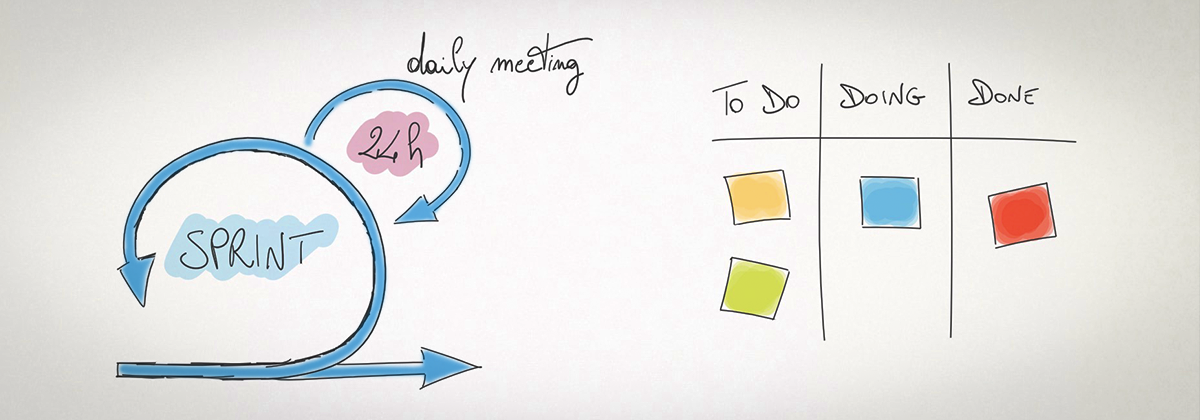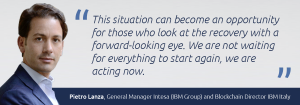Increasing the company success with an Agile Marketing approach
How to implement Agile in your Marketing team: methodology and mindset focused on the results.
Agile is a concept that derives from the values and principles of Agile software development, and it basically describes an innovative model of project management that enables the Marketing team to reach the targets more quickly, reducing the use of resources and improving the quality of the final results. In practical terms, a diverse team of developers establishes development objectives for a certain period of time, called Sprint. Subsequently, each member of the team works to complete the assigned tasks within the defined term; consequently, they carry out a review to measure the metrics and to define how to proceed to the next stage, which will coincide with a new Sprint.

Agile is a development approach that emphasizes the incremental releases for complex projects, the cross-functional and self-managed teams, the adaptive planning and continuous improvement. Every choice is weighted and selected on the basis of well-defined objectives and clear requirements of the identified clients (which can be either external or internal to the organization). A substantial difference between the Agile and traditional models also referred to as “waterfall”, lies in the methodology of allocation of work in short cycles, which allow you to get quick feedback on what has been developed in order to meet the expectations of the intended user.
In recent years this methodology has been successful also outside of the contexts of pure software development; in fact, it is rapidly spreading in other areas of the company management to support the management of digital innovation projects.
In the field of Marketing, Agile has to be interpreted as a process of research, testing, development, and implementation of communication projects and advertising campaigns according to an approach which prefers to release incremental content, the result of sequential iterations, with respect to “Big Bang” campaigns which last a few weeks, or even months. During the planning phase, the projects are divided into smaller tasks to be completed during the Sprint; at the end of each Sprint, the team discusses the results and identifies the areas of improvement that can be processed in the next Sprint, along with the new activities to take in the load.
If we go beyond the first layer of interpretation that is focused on techniques and tools, the Agile Marketing represents the mentality of the modern marketing organization that enables us to break down organizational silos, and complete projects quickly and efficiently, in tune with the rhythm of the technological changes that occur around us nowadays.
How to implement agility for the Marketing team?
Subsequently to the choice and after having shared the strategic plan with management and HR, one of the first steps to introduce the agile successful practices in the Marketing team is to have clear the difference between Scrum and Kanban, two essential pillars of the methodology that will work best together (also referred to Scrumban). Scrum is the framework that allows you to resolve complex problems by offering products of outstanding value through sequences of subsequent Sprints, which have been marked by planning meetings (Sprint Planning), alignment meetings (Daily Scrum or Stand-up) and verification meetings (Sprint Review and Sprint Retrospective). Kanban is the approach used to manage the work through the balance of the objectives and the production capacity of the team, as well as by the improvement of the way you manage the bottlenecks.

In the planning phase, called Sprint Planning, it is important to understand the amount of work the team can be in charge for in a short amount of time (usually a week or two – depends on the team) and agree, as a team, on the different tactics to be taken in a given period. The phases of verification of the results, the so-called Sprint Review and Sprint Retrospective, are important to understand the progress and to optimize the development of the overall plan. For the correct implementation of the model, a daily meeting lasting about 15 minutes play the main role as well, the so-called Stand-up meeting, during which each member of the team shares the activities conducted the day before, what will he/she deal with that same day, and the existence of any obstacle that do not allow you to carry out the assigned tasks. These meetings, apart from working as time alignment in which all the team members take part to, offer many other benefits, such as the improvement of the overall communication and the decision-making process, since they reduce the need for other meetings; they also help to identify obstacles as well as to improve the transparency and knowledge among the team members.
To start operating in agile mode there are no requirements for special tools, it is only necessary to prepare the team for the management of the Scrum and have a Board (Kanban) created on the basis of the needs of the team; the essential tool will organize and assign projects that need to be developed. The Board should have a Backlog to catalogue projects that will be discussed with the team members. These projects have been assigned during the Sprint Planning and they will be then classified according to a progressive logic in relation to the stage of development (‘to do’, ‘in progress’, ‘completed’, ‘pending’, etc). Moreover, the Board serves as a dashboard control to allow the display of the overall work and keep everyone aligned and oriented towards the common objectives.
Useful tips for the start-up of a successful Agile Marketing project
The agile methodologies reduce the inefficiencies and increase the value of the projects at the same time. The Agile Marketing suggests to always maintain an overall view on the entire path that leads to the creation of value for the customer, before anything else. During the implementation phase of the project it is advisable to pay attention to some fundamental aspects:
- make sure that the Board is always available to everyone; take into consideration the implementation of a digital Board shared online, especially if there are people who work remotely;
- structure the Sprint with a duration of a maximum of two weeks; be sure to not neglect urgent tasks that may not have been included in the Sprint by adopting, at least at the beginning, the technique 80-20: 80% of the time allocated to the activities required for the Sprint, and the rest of the time is addressed urgent needs or to organize the work in view of the next Sprint. Optimize this proportion as the weeks pass by;
- do not neglect the daily meetings (Daily Scrum or Stand-up); these short team meetings are crucial to keep everyone aligned in the direction of the common objectives.
- for more structured projects (e.g. an event, a launch campaign of a product or service, the redesign of the website, etc) schedule sessions of the retrospective analysis, which can also be extended to those stakeholders external to the team; these sessions are essential for the understanding of what went well and what could have been better;
- consider the possibility to require the members of the team to comment on the activities that are not completed within the agreed time; this stage can help each member of the team to stop and reflect on the real reason that caused the obstacle, and possibly find the solution, in case there are any;
- do not let the “pending” activities pile up; define the priorities for the tasks that provide sharable value, which is to say the Minimum Viable Product (MVP) = the minimum product to be released. Do not wait until the end of each Sprint to analyze and remove any element that causes this obstacle.
Thanks to the implementation of a strategy divided into many iterative steps it is possible to constantly monitor the progress of activities in favor of a constant learning that enables the company and its offer to stay aligned with the market changes and the needs of the users. However, it is important to pay a lot of attention to the obstacles that can arise during the practice of Agile Marketing.
Here are some common mistakes to avoid
- lack of a shared vision;
- lack of transparency and communication;
- lack of trust between team members;
- ignoring the feedback and metrics, in favor of the instinct;
- thinking that the tools or the process of management can lead to the transformation;
When we talk about Agile Marketing, the adopted tools and patterns represent only the path to follow, everything else relies on the mentality of the team (90% mindset, 10% methodology and process). In fact, agile transformations with the best results can be found in those organizations whose methodology has permeated both the way the projects are managed and the minds of team members. Changing the way people think and act is, indeed, the most difficult part of the Agile Marketing projects, yet the results of the investment in the short and long term may be noticeable already after a few weeks: it is thanks to the agility that the organizations will be able to control the change and exploit at the best the innovation.




